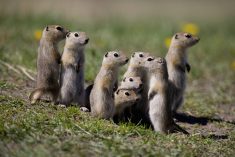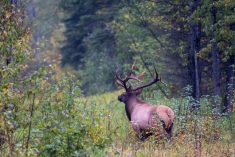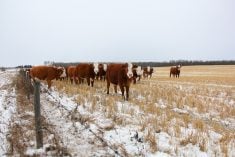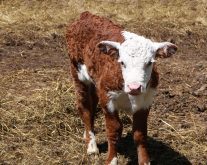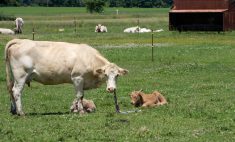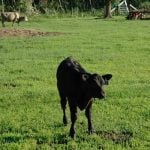Predators have always been a challenge when raising livestock. But with more herds calving on pasture in the spring and recovering wildlife populations, many ranchers in the West are seeing more predators than in times past.
Jim Lynch-Staunton of Antelope Butte Livestock, in the foothills of southern Alberta, is one of those ranchers.
“We’ve had grizzlies coming into our calving fields, and in the past five years lost two baby calves to bears. Those were confirmed kills, and we have a predator loss program that pays for those. All the ranchers here have the Fish and Wildlife people on speed-dial. They are good at coming out to examine a dead animal to figure out what kind of predator killed it. Through bear-awareness courses, we know that whenever we have dead animals, we will have bears coming in to eat that carcass.”
Read Also
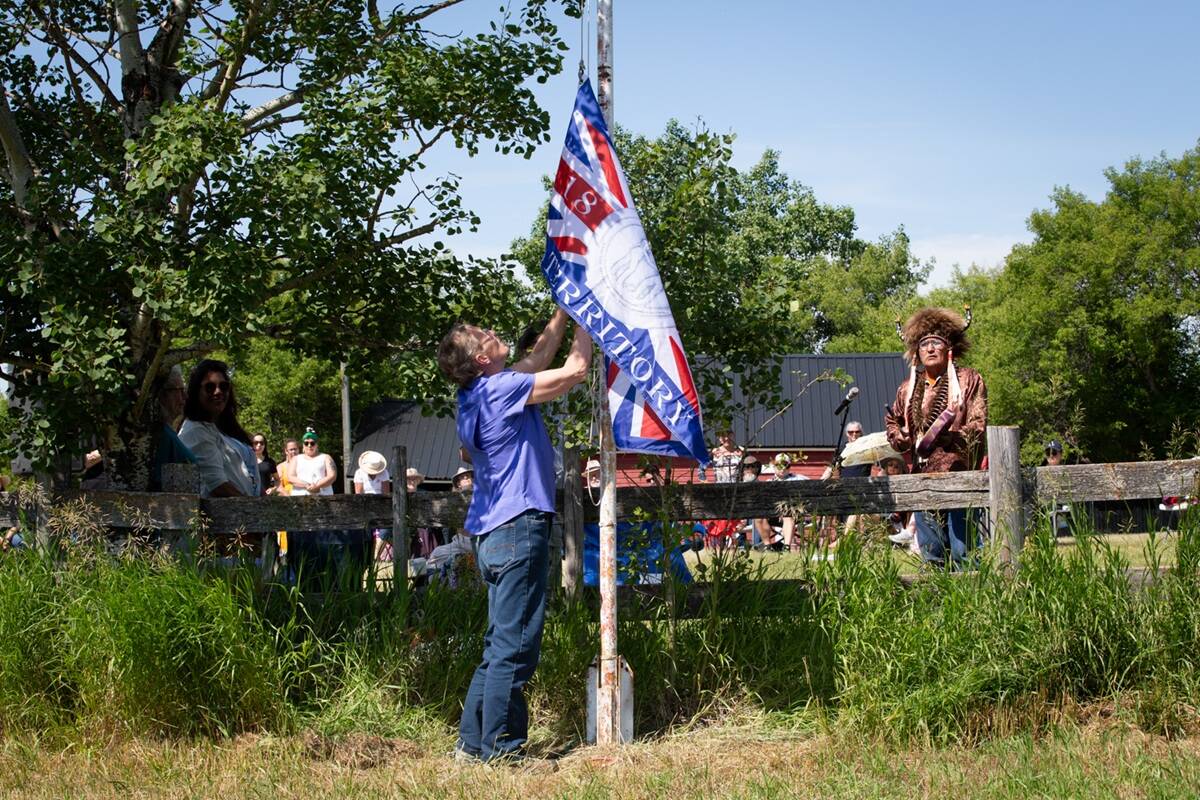
Treaty Land Sharing Network expands reach in Saskatchewan and Alberta
The Treaty Land Sharing Network, which connects land holders with First Nations and Metis people, has expanded since it began in 2018
Lynch-Staunton says that earlier in his life, it used to be “big news” to hear about a bear in his region, and people never saw bears near the house.
“The last time we had a grizzly, she was bringing her cubs to eat grain that came out the bottom of a greenfeed bale. Some attractants are difficult to do much about. One bear jumped into the corral by our house to kill the milk cow’s calf and dragged it under the fence, to eat it right in our yard,” he says.
Predation extends beyond the calving season. Brett Marshall, a rancher in southern Alberta, lost two cows and a calf to grizzly bears this spring after his cattle went to summer pasture.
“These bears are increasing in number, moving into new territory. Our ranch is in the foothills of the Canadian Rockies, west of Water Valley. We’ve lost a few cattle to bears in the past, but this was the most we’ve lost in one year. The wildlife officers suggested we move our cattle closer to home for a couple weeks, then send them back out. That seemed to help, but grizzlies are unpredictable,” Marshall says.
“We’re not sure what we’ll do next spring to protect the cattle. It’s mainly in the spring that we have trouble with grizzlies. The wildlife people have trapped a few bears that were causing problems, but usually they just relocate them, and hope they don’t continue to kill livestock in the new area.”
The bears that killed his cattle were young adults. “Bears keep their cubs with them for two or three years and these were probably the first year on their own,” Marshall says.
Dr. Eugene Janzen, University of Calgary, fields grizzly concerns from ranchers.

“One grazing association has a pasture for breeding heifers and sometimes finds remains of a carcass. They’ve asked me on occasion to try to determine whether it was sick and died, or killed. It’s not uncommon for grizzlies to lie in wait for prey. The bear hunkers down in the brush and the heifers, being curious, approach the motionless bear,” Janzen says. The bear will grab the animal by the nose, closing off the airway, bite its neck or back or kill it with a swat, breaking its neck.
Heidi Bennett of WA Ranches, near Calgary, also runs cattle in the foothills. “We don’t have much issue with predation during calving season, though we generally find a couple calves each season that are too scavenged to do a necropsy. It’s hard to know if they died or whether something killed them. Our cows are protective mamas, and generally keep coyotes out of calving fields,” she says.
Bennett says they’ve had predation issues on their leases west of Cochrane and Water Valley in the past. She and her crew saw wolves at different times last year, and found a heifer calf last fall that had been attacked by wolves.
“We treated her, and she will recover. On one lease where we’ve sighted wolves, we tried to be out there more often, watching the herd for signs of stress that might indicate predators are bothering them.”
Bennett says she typically sees one or two predation deaths each season on their lease lands. Some years when a larger number of calves (10-15 head) are missing in the fall, they see more wolves around, she says. Neighbours also report missing calves to wolves, so those calves were likely lost to wolves as well.
Trina and Dave Lowe have a ranch northwest of Cochrane, Alberta, but use summer pastures as far south as Indian Grave, west of Nanton. They’ve had losses to wolves, cougars and grizzly bears, but wolves are their biggest problem.
“We lost a cow to a grizzly last summer but we’ve only had occasional losses to bears. We also summer cattle on a forest reserve 15 miles west of us. This is where we have the most problems, with wolves. Dave brought 38 cows home early from that pasture and three were dry. We still have 170 pairs up there and we don’t know yet if some of them have lost their calves,” Trina Lowe says.
“Four years ago, we took 200 cow-calf pairs up and brought only 180 calves home. There are many wolves in that area, and the guy who rides for us in the summer ran a trap line there, which kept wolf problems to a minimum. He sold his trap line to some younger guys and the first two winters they were still figuring things out — and that’s when we lost the most calves,” she says.
A female wolf usually has about eight pups each year, so they can multiply quickly. “Sometimes when you just take out part of a pack it just splits them up and they start new packs.”
Lowe says they’ve had bigger problems within the last seven years, and predators are now killing animals closer to home. One year they had several new calves on the feed ground, dead, without a mark on them, and discovered that a cougar was killing them.
“The Fish and Game officer did a necropsy and told us the reason there’s no mark on the calf is that the cougar just chokes the animal.”
Another fall the Lowes lost two cows. After the second one, the Fish and Game officer took samples of the cows’ hides and their heads.
“They were able to tell from teeth marks and bruising that it was a grizzly, and explained how they kill and the differences between a wolf kill and a bear kill. They rehydrated the hide, and the puncture marks and bruising showed up, which meant the bear killed the animal and didn’t just eat it after it was dead. There were teeth marks in the cow’s nose, and it was a really big bear. This is one way a bear kills; it grabs and holds onto the end of the nose and suffocates the cow, crushing the nose. This showed up on both cows, and we got paid for those,” Lowe says.
Bears are a problem, but not as economically devastating as wolves, says Lynch-Staunton. “A pack of wolves can do a lot more damage. Not only do they kill, but also harass the rest of the cattle.”
There are many unseen losses from wolves that add up. The cattle may not stay in areas they are supposed to, and the stress from wolf harassment results in lower weight gains and lower pregnancy rates.
“None of the compensation programs will compensate for lack of gain. Cattle may go from gaining 1.5 pounds per day to only half a pound per day, or no gain at all. I had many conversations with Bud Williams before he died, about dealing with wolves. He said that any of the great things you can do with stockmanship and locating cattle — and having them stay in desired range areas — can be completely undone by wolves. This is a problem we’ll have to deal with,” says Lynch-Staunton.
Reconciling observations with science
Ranchers in the foothills have observed more bears in recent years. For example, Trina Lowe says one neighbour lost seven calves to grizzlies last summer, and another had trouble with bears raiding his beehives and chicken coop.
“More people have bear stories, whereas 30 years ago there were no grizzlies.”
But not everyone agrees on why ranchers are seeing more bears, or even if there are more bears. Numerous bear studies have been done in recent decades, trying to count grizzlies, but researchers didn’t necessarily conclude there were more bears. Grizzlies in Alberta have been listed as threatened since 2010. A population estimate in southwestern Alberta in 2007 estimated 51 grizzlies in that bear management area, which contains the southwestern corner of Alberta bordering British Columbia and Montana.
“Science on some of those studies was flawed and they didn’t find bears,” says Lynch-Staunton. “A tremendous amount of energy and effort was put toward protecting something that they thought at the time was seriously endangered.”

There has also been debate about why bears are moving from the mountains to the foothills. Lowe thinks that as bear populations increase in the mountains, some bears get pushed out by other bears and seek their own territory in the foothills.
“Some people think they are pushed out of the mountains because there are more people out there now, but that doesn’t make sense because these bears are moving into areas with even more people,” she says.
Recent research points to some answers. Dr. Andrea Morehouse, Winisk Research and Consulting, studies predators and predation issues. Her master’s degree examined wolf diets in southwestern Alberta, confirming their diets included livestock.
She did her PhD at the University of Alberta and started studying grizzly bears. Since finishing that work in 2016, she’s been working independently with her own research and consulting company.
“I work with groups and organizations on issues related to large carnivores and ways to mitigate conflicts,” she says. Much of her current work is in collaboration with the Waterton Biosphere Reserve Association and their Carnivore and Communities program, where she is also the science and stewardship co-ordinator.
“This group works with landowners and ranchers, trying to reduce conflicts. My role has been to provide the science perspective,” says Morehouse. She has done population estimates and several studies on the diet and behaviour of various predators.
There are seven bear management areas in Alberta. Morehouse and her colleagues decided to updated the population estimate for the southwestern area, so they conducted fieldwork from 2011 to 2014.
“We found 67 resident bears, representing an increase of about four per cent per year.”
What was interesting is that some times of the year there are many more bears. Morehouse explains that although we manage most species within provincial and state boundaries, those animals move around. The bears in southwestern Alberta are part of a population that also occupies B.C. and Montana, and that total population is well over 1,000 bears, she says. So, in addition to the 67 resident bears, she looked at the bears travelling through the southwestern bear management area.
“There were 172 bears using this area over the course of a year. These studies helped reconcile the differences in what people were seeing. Provincial estimates stated certain numbers but local communities were seeing a lot more; many bears are coming through even though we don’t consider them resident bears,” she says.
To figure out how many bears were in the area, researchers collected bear hair from rub trees and pulled DNA from those samples.
“With that genetic database, we collaborated with people doing similar work in British Columbia and Montana and created a family tree for bears. This enabled us to answer additional questions about bears in the area, and gave us a lot more than just numbers,” she says.
For example, some grizzlies kill livestock while others don’t bother them. Morehouse and her colleagues wondered if there were genetic clues to those behavioural differences.
“Using the DNA information, that was one of the things we looked at, to see if we could find evidence of social learning. If mom is causing problems and eating cattle, will her offspring kill cattle? Not surprisingly, we found evidence of that,” she says.
“Livestock depredation is a tough challenge but not the only one,” says Morehouse. “There are other agricultural attractants such as grain bins and various crops. Bears may come in and eat anything they can find. The livestock depredation is more challenging however; you can put electric fence around a grain bin, but it’s hard to protect cattle on big pastures.”
Mitigation and compensation
The provinces have various programs for compensating livestock owners for confirmed kills by certain predators such as bears, wolves and cougars. In British Columbia, the B.C. Cattlemen’s Association (BCCA) administers the program for that province.
Cam Hill, program co-ordinator with the BCCA’s Livestock Protection Program, says this program is now in its sixth year. “In our current program, in co-ordination with the Conservation Officer Service, we have about 900 individuals in B.C. who have taken verification training. Most of them are ranchers or producers, some are trappers and some are retired conservation officers like myself.”
The six-hour course teaches participants how to examine dead animals, and determine whether the animal was killed by a predator, what killed it, or whether it died of some other cause, Hill explains.
“They are also taught to look at injured animals to recognize signs of harassment. Evidence is gathered with photo documentation. Kills are skinned to prove or disprove predator involvement; they look for bruising under the hide, measure canine bite marks, etc. They also are trained to look for signs around the area such as tracks, scat, etc. and determine predator behaviour.”
The first step for a B.C. rancher who loses an animal is to report it as soon as possible. B.C. producers can call Hill at 1-844-852-5788.
“I’ll get the details and dispatch a verifier, though in many cases producers can verify their own dead stock. They don’t make the final decision; the verifier gathers the evidence, takes photos, fills out the paperwork and sends it to me. I review it with a representative from the Ministry of Agriculture who is involved with compensation. If I believe it’s a wolf or coyote kill, the next stage is mitigation.”
If the evidence points to cougar or bear, the file is referred to the Conservation Officer Service. Hill says they have about 50 wildlife specialists in the province, and all are licensed trappers.
“If it turns out to be a kill by a coyote or wolf, a wildlife specialist may be dispatched to remove the individual animal or pack that is responsible.”
In neighbouring Alberta, Janzen says that depredation is a “big issue” for veterinarians doing necropsies, and for producers, as they try to figure out the difference between predation and scavenged animals.
“Conservation officers are often called to verify kills because the rancher can be compensated. I am encouraged by this (compensation) since cattle share the land with wildlife, and this sharing is attractive to society,” says Janzen.
Ranchers are also doing what they can to prevent conflicts and predation. Most ranchers are proactive in removing dead animals so those won’t attract bears, says Lynch-Staunton.
“There are removal programs in some regions, but nothing here. So we take our dead animals to the back of our place where we don’t mind if bears eat them. We also do this in co-ordination with the trapper who traps wolves. Disposal sites make good sites for trapping wolves.”
The people at Fish and Wildlife have instructed ranchers to make the areas around their buildings uncomfortable for bears, Lynch-Staunton adds. “If we see a bear we’ve been told to get on a four-wheeler and be aggressive; chase them, yell and make a lot of noise. Maybe shoot in the air or use bear bangers when bears are around.”
Sometimes Fish and Wildlife officers trap and relocate a bear that keeps killing livestock, but they prefer to chase it away. One of the local Fish and Wildlife officers has trained Karelian bear dogs. These dogs are a Finnish breed used for hunting large animals, including bears.
“They bring in these dogs and chase the bears, making them feel uncomfortable. These programs are effective, if they continue to be funded,” says Lynch-Staunton. But the dogs are expensive and must be trained, and replaced if they get injured and as they age.
Generally, Canadians want more wildlife, including predators, on the landscape. In Janzen’s view, society should then make sure it works so that ranchers can co-exist with predators.
“If society wants livestock and wildlife sharing the same space, society must be prepared to accept the fact that predation will occur — and be prepared to pay for those losses.”



